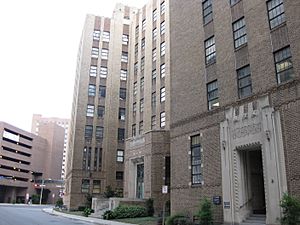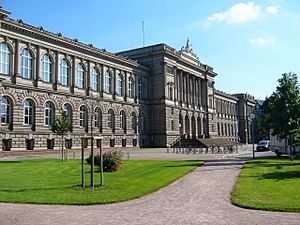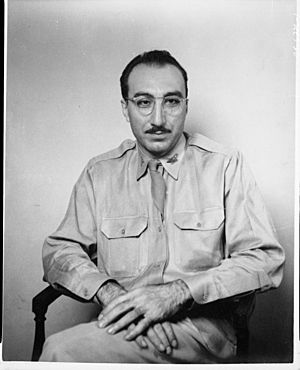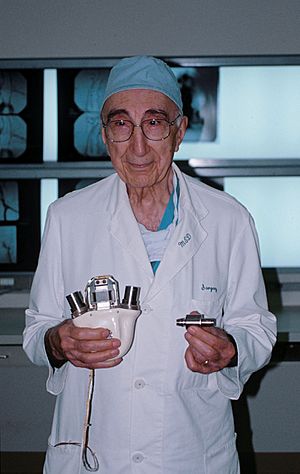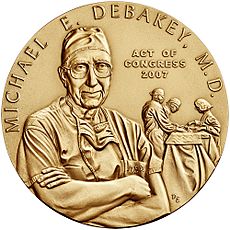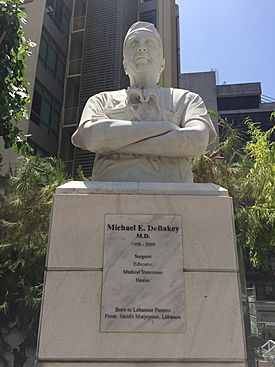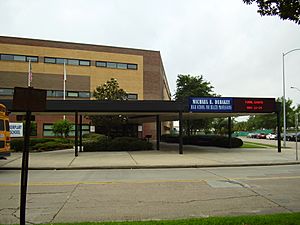Michael DeBakey facts for kids
Quick facts for kids
Michael DeBakey
|
|
|---|---|
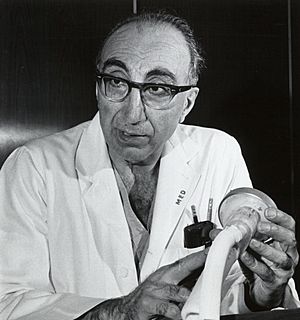 |
|
| Born |
Michel Dabaghi
September 7, 1908 |
| Died | July 11, 2008 (aged 99) Houston, Texas, US
|
| Education | Tulane University (BS, MD) |
| Occupation | Cardiovascular surgeon |
| Relatives | Lois DeBakey (sister) Selma DeBakey (sister) |
| Medical career | |
| Profession | Surgeon |
| Institutions | Tulane University |
| Research |
|
| Awards |
|
Michael Ellis DeBakey (born September 7, 1908 – died July 11, 2008) was a very famous American surgeon, scientist, and medical teacher. He became a leader at the Baylor College of Medicine in Houston, Texas. His amazing career in medicine lasted for almost 80 years.
Michael DeBakey was born to parents who came from Lebanon. He became interested in medicine after meeting doctors at his dad's pharmacy. His mom also taught him how to sew, which surprisingly helped him later in surgery! He went to Tulane University for his studies. While in medical school, he invented a special pump. This pump was first used to move blood directly from one person to another. Later, it became a key part of the heart–lung machine, which helps patients during heart surgery.
After his training, DeBakey returned to Tulane University in 1937. During World War II, he worked with the US Army's medical team. He also helped create the Veterans Administration, which supports former soldiers. DeBakey made many important breakthroughs in surgery. He found new ways to fix problems with the main artery of the body (the aorta). He also helped create devices that assist the heart and introduced artificial materials to replace damaged blood vessels. He received many top awards for his work, including the Presidential Medal of Freedom and the Congressional Gold Medal. Many medical places are named after him today.
Contents
Early Life and Learning
Michael DeBakey was born in Lake Charles, Louisiana, on September 7, 1908. His parents, Shiker and Raheeja Dabaghi, came from Lebanon. They changed their last name to DeBakey before Michael was born. His father, Shiker, was a traveling salesman who started businesses in Lake Charles. Young Michael helped his dad with chores and keeping records.
Michael was the oldest of five children. His brother, Ernest, also became a doctor, focusing on surgery. His sisters, Lois and Selma, were also very smart. They later joined Michael at Baylor College of Medicine as teachers in medical communication.
As a child, DeBakey learned to play the saxophone. His mother taught him how to sew, crochet, knit, and tat. He could sew his own shirt by the time he was 10! He also loved to read the Encyclopædia Britannica and reportedly read it all the way through. He learned French and German and was a Boy Scout. He even won awards for vegetables he grew in his garden.
Medical School Days
DeBakey went to Tulane University. He joined a special six-year program that combined his college and medical studies. He earned his Bachelor of Science degree in 1930 and became a doctor (M.D.) in 1932.
During his last year of medical school, DeBakey invented something amazing. Before there were blood banks, he took old pumps and rubber tubes and created a new kind of pump called a roller pump. He used this pump to move blood directly from one person to another. This invention later became a key part of the heart–lung machine, which is used in many modern surgeries.
Advanced Surgical Training
From 1933 to 1935, DeBakey stayed in New Orleans. He completed his internship and residency in surgery at Charity Hospital. In 1935, he earned a Master of Surgery degree for his research on stomach ulcers.
Like many ambitious surgeons of his time, DeBakey traveled to Europe for more training. He studied at the University of Strasbourg in France and the University of Heidelberg in Germany.
After returning, DeBakey taught surgery at Tulane Medical School from 1937 to 1948. In 1939, with his mentor Alton Ochsner, he suggested a strong link between smoking and lung cancer. This idea was later proven true by other researchers.
World War II Service
During World War II, DeBakey served in the US Army. He worked in the Surgical Consultants’ Division, helping to guide surgical practices for the military. In 1945, he received the Legion of Merit award for his service.
After the war ended, he stayed in the US Army for another year. He played a big part in making sure wounded soldiers continued to receive good care. He also helped set up the Veterans Administration and the Medical Follow-Up Agency. After this, he went back to Tulane University.
Post-War Surgical Career
In 1948, DeBakey joined the Baylor College of Medicine in Houston. He led the surgery department until 1993. He also served as the college's president from 1969 to 1979. Later, he became its chancellor until 1996. He was a distinguished professor and director of the DeBakey Heart Center at Baylor.
DeBakey was a member of many important medical groups. He worked to improve healthcare standards both in the US and around the world. He served on the National Heart, Lung, and Blood Advisory Council of the National Institutes of Health three times.
In 1951, DeBakey hired another famous surgeon, Denton Cooley, at Baylor. They worked together for many years until Cooley left in 1969.
Helping the Shah of Iran
In 1980, Michael DeBakey was asked to help with the medical care of Mohammad Reza Pahlavi, the former leader of Iran. The Shah was very sick with a type of cancer. DeBakey oversaw a surgery in Cairo. Although the surgery was done, the Shah's illness was very advanced, and he passed away later that year.
Amazing Vascular Surgery
In the 1950s, DeBakey studied how blood vessels become blocked. This helped him create new ways to treat blood vessel diseases. He was looking for the best material to make artificial blood vessels. He found a fabric called Dacron at a department store. Using his wife's sewing machine, DeBakey made the very first artificial blood vessel grafts from Dacron. These grafts could replace or repair damaged blood vessels. He later worked with a researcher to create a machine that could knit these grafts.
In 1953, DeBakey performed the first successful carotid endarterectomy. This surgery clears blockages in the carotid artery, which supplies blood to the brain. A year later, he developed new ways to use grafts for different parts of the aorta, the body's largest artery.
DeBakey was also one of the first surgeons to perform coronary artery bypass surgery. He was a pioneer in creating an artificial heart. He was also one of the first to successfully use an external heart pump on a patient. This pump helped the left side of the heart.
In 1958, DeBakey performed the first successful patch-graft angioplasty. This procedure involved using a piece of Dacron or a vein to widen an artery that had become narrow. This helped the blood flow normally again.
Filming Surgeries
In the 1960s, DeBakey and his team were among the first surgeons to film their operations. This helped teach other doctors new surgical techniques.
Views on Animal Research
DeBakey started and led the Foundation for Biomedical Research (FBR). This group works to help people understand and support the use of animals in medical research. DeBakey used animals a lot in his own research. He believed that animal research was very important for finding new medical treatments for humans. He stated that scientists who do animal research care deeply about the animals. He said their goal is to find ways to reduce pain and suffering caused by diseases.
Later Surgical Career
Michael DeBakey continued to practice medicine until he passed away in 2008, at the age of 99. His contributions to medicine lasted for about 75 years. He operated on more than 60,000 patients, including several world leaders. In 1996, DeBakey and a team of American surgeons helped supervise a heart bypass surgery on Russian president Boris Yeltsin.
His Own Health Challenge
In late 2005, DeBakey himself suffered from an aortic dissection. This is the very condition he had pioneered surgery for years earlier. He felt a sharp chest pain and went to Houston Methodist Hospital. Doctors confirmed the diagnosis.
DeBakey first did not want to have surgery. But as he got worse, the surgical team decided to operate. At 98 years old, DeBakey became the oldest patient to have the surgery he himself had invented. The operation lasted seven hours. After a difficult recovery that took eight months in the hospital, DeBakey was released in September 2006. He returned to good health and lived for another two years.
Selected Honors and Awards
Michael DeBakey became a member of many important groups. He received 36 honorary degrees and hundreds of awards.
He was given the Presidential Medal of Freedom in 1969. In 1987, President Ronald Reagan gave him the National Medal of Science. He was also named a "Living Legend" by the Library of Congress in 2000. On April 23, 2008, he received the Congressional Gold Medal from President George W. Bush.
Some of DeBakey's major awards include:
- US Army Legion of Merit (1945)
- American Medical Association Hektoen Gold Medal (1954 and 1970)
- Albert Lasker Award for Clinical Medical Research (1963)
- American Academy of Achievement's Golden Plate Award (1967)
- Medal of Freedom with Distinction (1969)
- Eleanor Roosevelt Humanitarian Award (1969)
- National Medal of Science (1987)
- Lomonosov Gold Medal, Russian Academy of Sciences (2003)
Family Life
DeBakey married Diana Cooper in 1937. They had four sons: Michael, Dennis, Ernest, and Barry. After Diana passed away in 1972, he married Katrin Fehlhaber, a German actress. They had one daughter, Olga-Katarina.
People who worked with DeBakey sometimes described him as a "tough taskmaster." One former trainee said he could be very kind to patients and medical students, but very strict with surgical residents.
Death and His Legacy
Michael DeBakey passed away from natural causes at Houston Methodist Hospital on July 11, 2008. He was 99 years old. He was the first person ever to have his body lie in repose at Houston City Hall. He was buried at Arlington National Cemetery. In 2009, he became the first person to receive the Denton A. Cooley Leadership Award after his death.
Michael E. DeBakey International Surgical Society
In 1976, DeBakey's former students created a society in his honor. It is now called the Michael E. DeBakey International Surgical Society. Every two years, they give out the Michael E. DeBakey Surgical Award.
Lasker-DeBakey Clinical Medical Research Award
The Albert Lasker Award for Clinical Medical Research is a very important medical award. In 2008, it was renamed the Lasker-DeBakey Clinical Medical Research Award to honor Michael DeBakey.
Michael E. DeBakey Library and Museum
In 2008, DeBakey attended the start of construction for the new Michael E. DeBakey Library and Museum. This museum at Baylor College of Medicine honors his life, work, and dedication to helping others and teaching. The museum officially opened in May 2010.
DeBakey Medical Foundation
The DeBakey Medical Foundation gives out the Michael E. DeBakey, M.D., Excellence in Research Awards each year. These awards recognize professors who have done amazing scientific research. The foundation also helped create a scholarship fund at Baylor University. Students who receive this scholarship are called "DeBakey Scholars."
Other Places Named After DeBakey
Many places are named after Michael DeBakey. These include:
- The DeBakey High School for Health Professions in Houston.
- The Houston Methodist DeBakey Heart & Vascular Center.
- The Michael E. DeBakey Veterans Affairs Medical Center in Houston.
- The Michael E. DeBakey Heart Institute in Kansas.
- Special surgical tools, like certain clamps and forceps, also bear his name.
- The Michael E. DeBakey Institute for cardiovascular research at Texas A&M College of Veterinary Medicine & Biomedical Sciences.
|
See also
 In Spanish: Michael E. DeBakey para niños
In Spanish: Michael E. DeBakey para niños


